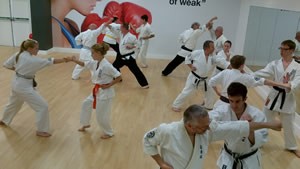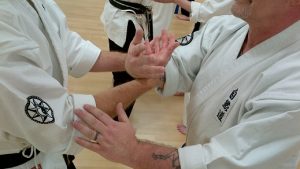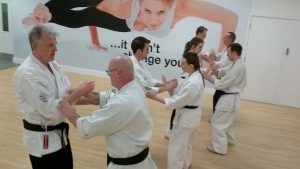Ippon Kumite Pairs Work
Ippon Kumite is one type of pairs work or traditional two person kata. It is trained both ways round, wherein the student can develop the basic skills with a partner learnt from kata also. There are twelve sets of Ippons in this section which offer a variety of techniques. This is the foundation to our system and will develop into the strategies within the Tegummi section. This set of Ippons will teach the angles and positions for attack and defence, these are the most important parts to the system to gain the proper body alignment under the conditions of attack and defence. These body positions are the same in Kata, where the student trains solo but in Ippon the student is structure tested under attack and defence, making the adjustments needed to develop good Karate skills.
Te Uke Tsuki Waza Renshu pairs work hand receiving techniques
This section covers the training (Renshu) of the four Uke Tsuki and Te, developing (Nagasu) the flow using (Maai) the combative distance, to develop the use and feel of the these techniques (Giho). These exercises (Undo) can be trained in many different combinations and various stances within (Chikama), which is the close interval range at which you can strike your partner without taking a step. Application can then be added to these drills
Kihon Kumite Pairs Work
The ten Kihon Kumite skills are the pinnacle of the system and are also classed as two persons kata. The principles of this set are neutralizing the opponent’s attack through sensitivity and body placement. Neutralisation techniques are very difficult to do and require perfect timing and is the arts highest achievement. To stop an attack in its track with the minim of energy and movement causing the attackers energy to stifle taking control of both the attacker and space he occupies. Kihon Kumite concept is to take the line of force from an opponent, and deliver this force back with the added force of the defender. The stepping is swift and light with a rooted stance on the final strike, the shifting and avoiding of the opponent’s attack are characterized by circular movements of Kihon Kumite. The pace of this pairs work tends to be slightly slower, the attacks are strong yet soft, they encompass the two elements of Go and Ju (Hard-Yang and soft-Yin). Ippon Kumite and Ohyo Kumite are the two opposites that make up Kihon Kumite. The attacks and defences tend to be closer and is the correct Kata range for Shi Zen Do’s Tegumi, Kensetsu and Nage Waza.
Tegumi Pairs Work
Sticky hands/Tegumi training involves a simultaneous process of sticking and adhering with the hands and connecting and following with the legs. The hands act as a glue, while the feet and legs enable the practitioner to follow the opponent’s changing directions. This nuanced interplay is crucial in a martial context where encounters involve multiple angles and rapid changes in direction. It’s important to note that the goal of sticky hands training extends beyond the development of techniques. While in-class training involves conscious thought processes and the accumulation of information from training partners, the ultimate objective is to cultivate an intuitive energy through contact. This intuition becomes a valuable asset in self-defence situations, allowing practitioners to react correctly without relying on conscious reasoning. The entire process, from sticky hands initiation to the decisive strike, unfolds in a fraction of a second. This swift and efficient response is a testament to the intuitive energy cultivated through years of dedicated training. It highlights the seamless integration of sensory awareness, balance, and instinctive reactions – the essence it’s the arts sixth sense developed through the art of sticky hands.
Kensetsu Pairs Work
This is the joint locking system of Shi Zen Do. These are the immobilizing and seizing techniques a two person prearranged form performed in a unbroken flow of movement each lock skilfully blends into the next. When the student acquires the correct skill level and can perform the sequence, these locks are then applied through the Tegumi section. There are thirteen basic locks to this section but more are added through a natural progression. The student infills the gaps by a process of gaining insight. In class training, the student employs Ji Yu training, this translates as freestyle, its here the student incorporates the use of all the above training methods flowing for boxing to grappling, locking and throwing.
Ohyo Kumite Pairs Work
This tends to be more complex. The two students here partake in an exchange of attacking and defending roles in one set of pairs work which flow back and forth. The pace of Ohyo is lively and flowing which differs from the first set of pairs work covered in Ippon Kumite, these sets are light and explosive in nature and involve very complex manoeuvres such as turns, sweeps and take downs. Footwork and angles will further develop the students ability to skilfully control and subdue the opponent, whilst full control over their own.



